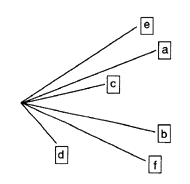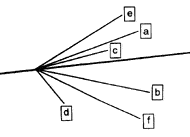Where Does Intelligence Come From?
Thomas Jackson, American Renaissance, July 1996
The g Factor, Christopher Brand, John Wiley & Sons, 1996, 253 pp.
It was the great British psychologist, Charles Spearman (1863–1945), who first proposed the concept of g, or general intelligence. He saw that intelligence manifests itself in many ways but believed that there was a unitary, underlying ability that accounted for these manifestations. Spearman knew that physicists used the symbol G for the gravitational constant, and since he was searching for a “physics of the soul” he chose g as the symbol for general intelligence.

The existence of g is still a hotly-debated topic in psychology, but Christopher Brand has assembled some of the best evidence yet to show that it is real, can be measured, and is one of the most important determinants of success in life. His book, The g Factor, is not always easy to understand, but it is stuffed with information about the latest findings in intelligence testing.
Unfortunately, the book was abandoned by its publisher, John Wiley & Sons, immediately after the first reviews. Another publisher may take on the book, but even if it never reappears many of its ideas are well worth summarizing.
What is g?
Part of the reluctance to accept the concept of g is that, strictly speaking, it is a statistical artifact. Its existence cannot be proven, but it is strongly inferred from different kinds of intelligence testing.
A person who does well on one kind of intelligence test usually does well on other kinds, but different tests yield different scores. This figure is a hypothetical representation of the results of six different intelligence tests:

Although the figure is in two dimensions, it should be imagined to be in three dimensions, with each line angling out from the common center the way the ribs of a half-open umbrella (with the handle removed) angle out from the center. The longer the line, the higher the score on the test.
The lines all point in somewhat the same direction (to the right, and not to the left) so can all be understood to be indicating a common underlying tendency. By a statistical procedure known as factor analysis, it is possible to calculate what that common tendency is, and to derive a line that is the equivalent of the handle, or central member of the umbrella. A test that gave results along that very line would be a true test of the common factor, g, which all the other tests are thought to be measuring in some imperfect way.

In real life, intelligence tests that produce scores that are as close as possible to the common, central tendency are the most accurate and reliable indicators of intelligence. They come the closest to measuring g, and are therefore said to be highly “g-loaded.” No single test has yet been devised that measures g directly, but a combination of g-loaded tests gives a very good indication of intelligence.
Occasionally, a person does well on some IQ tests but not on others, but ordinarily a good score on one predicts good scores on the rest. As Mr. Brand points out, across-the-board high scores on tests that are methodologically quite different from each other refute the commonly-held view that high IQ is the result of some kind of (usually unspecified) practice or training. Presumably, the kind of training that produces good scores on visual/spatial tests would not help on verbal tests, and time spent learning one kind of intelligence would be time taken away from learning the other. If that were the way intelligence is acquired it would be common for people to get high scores on one kind of test and low scores on others. Consistent scores (either high or low) suggest that tests are measuring some common or general ability.
Other Objections
Many people try to argue that there is no such thing as intelligence, or g, because there is no precise definition for it. However, people were able to measure weight long before they understood or could define gravity, and electricity can be measured without fully understanding electrons.
Mr. Brand explains that critics of IQ like to scoff at “mere academic intelligence,” claiming that IQ is an artificial indicator of an otherwise useless ability that the tests happen to measure. However, what the tests measure is exactly what is needed for success in all kinds of practical endeavors, and no one has ever devised a better measure of “real,” non-academic intelligence. Likewise, few people would be willing to give up 20 or 30 points of “mere test-taking ability” and be completely confident that nothing else in their lives would change.
Mr. Brand notes that many people have speculated that persistence or determination is what brings success in life as well as high IQ scores. In fact, it is easy to devise tests of persistence that involve repetitive movement or memorization of nonsense syllables. These require application but little intelligence, and high-IQ people do no better on them than anyone else. Likewise, in order to test the motivation hypothesis, researchers have offered subjects money if they do well on IQ tests, but the added incentive does not improve scores.
It is, of course, intelligent people who are most likely to mount sophisticated arguments about the unreality or irrelevance of intelligence. Mr. Brand suggests why this might be so. One reason is that most people choose friends and acquaintances who are similar to themselves in intelligence. Most smart people therefore associate only with people who are in a tiny segment of the full range of intelligence, and they begin to believe that everyone is like them and their friends.
Another reason is that personality differences and intellectual specialization become much more pronounced among people of high intelligence. It appears that genes govern the most basic aspects of intelligence but that after a certain relatively high threshold of intelligence, environment and individual choice lead people in a great variety of directions. For this reason it is easy for intellectuals to lose sight of the fact that it is probably only the presence of high levels of general intelligence that permit what appear to be strikingly different kinds of intellectual achievement.
The Doctrine of Environment
Of course, it remains dogma among egalitarians that differences in environment explain differences in achievement. Mr. Brand offers some interesting opposition to this view. It is often argued that blacks, for example, do poorly in life and on IQ tests because of some kind of environmental deprivation due to race.
An interesting parallel can be drawn between blacks and deaf people. Mr. Brand reports that, not surprisingly, deaf children get low scores on verbal intelligence tests. However, they get normal scores on non-verbal tests and by the time they are adults they have overcome most of the verbal deficit. Is it really more of a challenge — in ways that would retard intellectual development — to be black than to be deaf? Likewise, children with catastrophic motor disabilities, who lead lives that are severely restricted by any definition, apparently have higher tested intelligence levels than blacks who are not physically handicapped.
Perhaps the greatest direct assault on the environmentalist view comes from biology and physiology. As early as the 1960s, it was discovered that many mental illnesses are best treated with drugs. This instantly invalidated convoluted psychoanalytic theories about the central role of childhood experiences and other social variables — and cast doubt on environmental explanations for IQ differences.
“Inspection time” studies, which are Mr. Brand’s specialty, are an even more direct refutation of environmental claims. The classic experimental method involves use of a tachistoscope, which casts simple images on a screen for very brief periods that can be precisely timed. A common test would be to show two lines of different lengths and have the subject say which is longer. Images can be displayed so briefly that no one can make them out, but a firm pattern has been found, in which more intelligent people are better able to make out the images displayed for the shortest periods of time. Very high correlations of 0.65 and 0.7 have been found between intelligence and “inspection speed.”
Mr. Brand proposes that the tachistoscope measures a basic physiological correlate of intelligence: the speed at which a person acquires and decodes information. It is difficult to imagine a social or environmental explanation for differences in inspection time or for the strong correlation with intelligence. These results cannot be dismissed as some artificial measure of “what IQ tests test.” Unfortunately, Mr. Brand does not report data for different racial groups, but if inspection speed were strongly correlated with intelligence in one race but not in another, it would suggest racial differences in physiology far beyond the expectations of hereditarians.
Role of Environment
None of this is to say that environment has no effect on intelligence. Like many contemporary researchers, Mr. Brand estimates the heritability of individual differences in intelligence to be about 75 percent. Environment clearly has the strongest effect during the early years, when children have the least influence over their environments. In adolescence and adulthood, as their own genes increasingly govern their choices of environments, people more closely reflect more purely genetic propensities.
This is clear from adoption studies. The IQs of adopted children have a reported 0.13 correlation with IQs of adoptive mothers but a correlation twice as great with biological mothers. By mid-adolescence, the correlation with the adoptive mother has dropped close to zero while the correlation with the biological mother has increased slightly. Likewise, fraternal twins have more similar IQs when they are children — when their environments are established by their parents — than when they grow older and make their own choices. Identical twins, however, maintain their marked similarity of IQs throughout life, presumably because their identical genes push them to seek very similar environments even as adults.
In fact, as Mr. Brand points out, even small children establish their own environments to some degree. A bright, sunny child elicits different reactions from parents and strangers than does an ill-tempered one. Thus, even some of the effects on personality and intelligence that count as environmental are, to some degree, influenced by genes. As children grow older the parental environment increasingly becomes a reaction to the child’s genotype rather than an independent, external force.
Why is there so much resistance to genetic explanations for human difference, despite increasingly irrefutable evidence for it? One reason is a quasi-Marxist longing for human equality, what appears to be a genuine revulsion for the brute fact of unbridgeable gaps. Another seems to be a fear that genetic explanations would lead inevitably to forcible, eugenic measures.
The curious thing is that environmental explanations still leave what amount to unbridgeable gaps in achievement. Nor do they dispel the bogey of forcible government intervention that eugenicists, we are always warned, secretly desire. Massive transfers of wealth and decades of government intrusion have already failed to equalize achievement or even begin to narrow the black/white IQ gap. Even if the environmentalists were right, it would take unimaginable tyranny to equalize what even Communism failed to equalize. Mr. Brand argues that much of the opposition to genetics comes from people who make a living in the uplift trade and who would be exposed as useless if the truth were known.
The social engineers are not even self-consistent. As The g Factor notes, if parental environment counts for so much, liberals should be in the business of controlling procreation just as ruthlessly as they think eugenicists would. If environment accounts for everything, why do liberals not forbid all baby-making and child-rearing in housing projects?
Although Mr. Brand does not call for eugenics, the facts he assembles leave little doubt where his sympathies lie. He thinks it a disgrace that psychology has neglected and downplayed the reality and heritability of intelligence, and even accuses much of the profession of outright malpractice.
In The g Factor Mr. Brand proposes only one policy change that should logically follow acceptance of the reality of g: “streaming” or grouping of students by ability. He argues that squeamishness over inherent differences in ability fuels the current fashion for shoving everyone into the same classes, but this makes everyone suffer. Dim students hold the good ones back and good ones outstrip and humiliate the dim ones. Mr. Brand writes that there are perhaps a few talented teachers who can pitch the same lesson simultaneously to children of different abilities, but most cannot. Nor, he argues, is there any basis in the fear that bright children may not be “mature” enough to skip grades. Gifted children are happiest with friends of the same mental age, not chronological age.
All in all, this is an excellent little handbook on the current state of IQ research. It makes no claims the data do not support, and touches only briefly on the race-IQ question. Nowhere does it go beyond the generally accepted boundaries of psychometry. The braying in the British press and John Wiley & Son’s astonishing capitulation only show how rare good sense still is.















